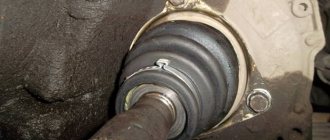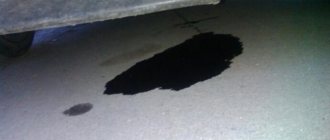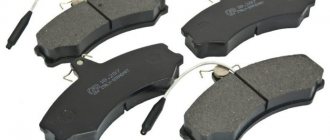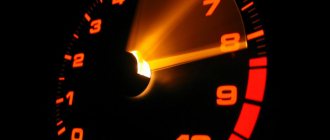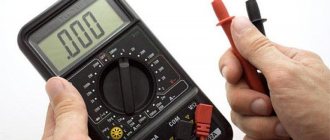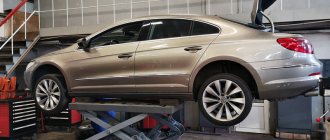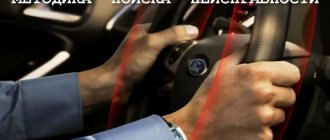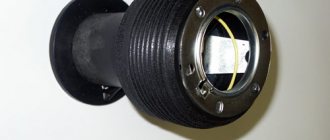If you hear a crunching sound when turning the steering wheel, you must urgently find the cause and eliminate it, as this can lead to serious consequences. The steering plays an important role in the design of the car, since your safety depends on its proper operation. Malfunctions of this system can lead to expensive repairs, as well as an emergency situation on the road.
A steering control that has malfunctions must be immediately returned to working condition at the first sign of problems. A common malfunction is a crunching sound when turning the steering wheel while driving. Having discovered this malfunction, you cannot delay repairing this mechanism. But first you need to make a diagnosis. Some people immediately go to a car repair shop, others repair their “iron horse” with their own hands.
Both of these car owners made the right decision in their own way, as there are advantages and disadvantages in both cases. If we talk about the repair and diagnosis of the steering mechanism at a service station, then the main advantages of such treatment are that it is possible to accurately and quickly diagnose the malfunction, and also eliminate it quite quickly. The downside is that it is a waste of money, and the steering costs a lot, and its repair will be expensive, so you should think carefully before contacting a car repair shop.
This work is quite complicated, since when you turn the steering wheel, not only the steering mechanism works, but also many other components: CV joints, steering tips and rods, wheels, etc. Therefore, it is difficult to immediately say where the crunching comes from when the steering wheel rotates. It may not be related to the steering.
Pomegranates crunch
When you turn the steering wheel while driving, you hear a crunching sound. From the very beginning, the thought arises that this is a malfunction of the angular velocity joints, simply called grenades.
The steering action is performed without any extraneous noise or sounds, but when this system is damaged, a specific sound similar to a crunch often appears. It lets the driver know that in the near future such symptoms will lead to unpleasant moments:
- The CV joint can suddenly fly out of its seat and cause damage to the car engine.
- The linkage with the wheel may fly out, which will lead to an accident on the road.
- Along with the sounds, the car vibrates when the wheel is turned all the way.
- When turning, the wheel begins to brake and slide along the road.
- Slow cessation of steering action and blocking of the entire mechanism.
If extraneous noises or sounds arise from the car, you must immediately find out the cause of its occurrence and quickly take corrective measures. In this case, to resume steering operation, it is necessary to install a working part together with new boots.
What motorists say about the squeaking sound in the wheel when turning the steering wheel
- The ball is creaking “The ball is still creaking. When my boot was torn, the ball squeaked like an ungreased cart, and the sound was similar to the sound of rubbing rubber. Once I sprayed it with Vedashka, the squeak went away, but a new ball joint is required.”
- How to diagnose a squeaking noise
“First try to grab the inside of the left wheel and pump it up to the limit. The knocking sound of the bearing or ball will be clearly audible. Another reason may be due to the pad touching the disc or the integrity of the anthers. Check the calipers, especially the guides. Maybe I’ll need to buy a caliper repair kit.” - It happens that the squeak is not at all where you are looking for
“I noticed a squeak in the right front wheel. I pumped both at once, but nothing changed. I hung the right front wheel in the pit and put it in gear. It turns out that the rubber band on the cardan suspension bearing was torn, small pebbles got into it, and a squeaking sound occurred. I advise you to stop by the pit and check it out.” - You won’t immediately notice a major breakdown
“I also encountered a similar problem. I immediately thought about a shock absorber, but while changing the front bearings I noticed a burst spring on the upper first coil. It is strange that the spring burst, but the car did not sag, but only creaked. So watch everything very carefully.” - Uncharacteristic causes of squeaking
“I also think that the squeaking may occur due to a problem in the locking ring (more like a whistle when turning the wheel at low speed). When unclenched, the ring will leave the groove, and it will “eat” it. Why at the turn? The wheel will be pulled by the CV joint and axle shaft. The plate on the hub nut presses the ring on one side. On the other hand, the CV joint axle acts as the sharp edge of the ring groove.The squeak is first noticeable when you go through a turn, then on the straights.
To check, remove the hub (you can even do it without removing the wheel), remove the ring with the washer. If you see a track on the puck and a worn out inner edge on the ring, the ring needs to be replaced.”
Crunch in the steering rack
An experienced car owner can quickly distinguish the crunch of a grenade from the noise coming from the steering rack. This does not happen often, but its occurrence cannot be ruled out. This malfunction is characterized by the following factors:
- Crunching sound when turning the steering wheel in place.
- Vibration of the steering wheel when driving on a flat road surface.
- The car doesn't listen well to the steering wheel.
- When turning the steering wheel, a lot of force is required, or vice versa, it is too easy.
- With the engine turned off, when the steering wheel is turned all the way in one direction, a metallic click is heard and there is a slight play.
If such breakdowns are identified, they must be repaired quickly. Most often, the steering rack needs to be replaced with a new one, but there are professional craftsmen who can rebuild this unit and prolong its operation. This solution is not used in practice by ordinary car owners, since after restoration this unit will not work for long. Therefore, it is better and easier to completely replace it with a new product.
It is very difficult to replace the steering rack yourself, so it is advisable to contact a car repair shop.
Steering wheel
A crunch or squeak is heard directly inside the car and has nothing to do with the steering mechanism. Most often, such a malfunction occurs in inexpensive brands of cars due to poor quality processing of body parts. The reason lies in the friction of the steering wheel on the plastic, the laxity of various fastenings, for example, signal delivery devices.
This malfunction does not require much effort to solve the problem. The steering wheel must be disassembled and removed; if necessary, the upper part of the plastic elements of the steering column must be cleaned.
Steering knuckle bearings
If, when turning the steering wheel, the driver hears an uncharacteristic squeak, which can sometimes appear quite suddenly, it is worth listening to the steering knuckle.
When the sound comes from there, the cause most likely lies in worn bearings.
These bearings can squeak and make cracking noises if there is no lubricant inside or if sand or other abrasive contaminants have entered the housing.
Untimely replacement can have dangerous consequences. It is recommended to remove the bearing from the steering knuckle and check it for defects. If they are not there, lubricant is added and the part is returned to its place. If defects are detected, a new bearing similar to the previous one is used.
Steering column
In this mechanism, crunching can be produced from the following sources:
- The body is made of cheap plastic in inexpensive cars.
- Extraneous noise may come from the steering column coupling, which can be eliminated by adding a certain amount of lubricant, the type of which depends on what material the coupling is made of.
- The column crosspiece, called the driveshaft, rubs against the boot located near the driver's feet, where the column meets the engine compartment. A crunch may occur after repairs due to slight misalignment of parts. The problem is solved by adding lubricant or WD-40.
- The steering column may be bent. A squeak appears on the surface, auxiliary signs are: shocks, vibration on the steering wheel. This malfunction can be eliminated by replacing the entire mechanism with a new unit, although a slight noise indicates a minor malfunction.
Noises from power steering
Despite the fact that electric power steering is being introduced very often today, the main driver assistant when steering in most passenger cars remains power steering. This unit may make noise due to a lack of working fluid. In this case, you need to add it to a tank specially designed for this purpose. Just add the same liquid that the manufacturer used, the amplifier itself is configured specifically for the operating parameters of a particular product, and the use of a different liquid can be very negatively perceived by the amplifier. In addition to the lack of working fluid, the cause of noise in the power steering can be its pump, if it is about to die, you also need to check the condition of the power steering belt, because certain difficulties can also arise with it. And if the condition of the power steering belt makes you suspicious, it is better to replace the belt.
Power steering
In the steering mechanism where it is mounted, this is the noisiest mechanism. When you turn the steering wheel of a stationary car, it produces a specific noise. An increase in this sound indicates that the fluid level in the power steering is insufficient. This issue is resolved by adding fluid to the expansion tank.
Other extraneous sounds in the form of whistling or creaking indicate serious malfunctions. Their causes may be wear of the power steering belt, or its weakening, penetration of air into the system, or breakdown of the power steering pump. It is advisable to identify and repair them in car repair services.
Common faults
If you hear an extraneous sound in the form of squeaks when you turn the steering wheel, this does not mean that the steering wheel itself is squeaking.
We have previously considered several situations related to the behavior of the steering wheel of a car. In particular, they talked about why the steering wheel pulls to the right, for what reasons it does not return to its original position, and also partially touched upon the steering mechanism in a conversation where they discussed why the car shakes at speed.
There are several main causes of such noise, which are associated with:
- wheel alignment;
- silent blocks;
- bearings;
- steering rack;
- column;
- rod ends;
- plastic casing;
- power steering;
- ball joints;
- CV joints.
Now we will try to briefly go through all these reasons, and help you figure out what is the matter specifically in your situation.
CV joint and ball
If your ball joint is worn out, this may be the likely cause of an unpleasant squeaking and knocking sound when you turn the steering wheel. Moreover, this can happen when the car is standing still or moving.
If the support is at fault, it is recommended to replace it immediately, since the risk of possible failure at speed is very high. To extend the life of this element, simply follow the rules of careful and adequate driving. At the same time, monitor the condition of the anthers. This is a rubber protective casing that prevents dust and other contaminants from entering the ball joint. By adhering to all these rules, the ball will certainly be able to serve its entire service life.
As for CV joints, they are important elements in transferring torque from the gearbox to the wheels. Its failure can be determined by a characteristic pronounced crunch when turning the steering wheel. Moreover, most often it is the external elements that crunch.
Here you need to change either the CV joint itself or the boot, add new lubricant and extend the service life of the unit.
power steering
Although electric boosters are being actively introduced into new cars, hydraulic elements remain the most common.
Power steering noise usually has the same cause on all cars. This is a shortage of special working fluid. The problem is solved quite simply. You need to open the neck on the hydraulic fluid filler tank and add the missing amount. It is only extremely important to use exactly the same liquid that is currently in the container. The combination of different compounds can lead to unpredictable, and most often negative, consequences.
see also
Trailer Stalker: characteristics, manufacturer, reviews, photos
In addition to fluid, a problem may also arise in the form of wear. If the power steering has been in service for quite a long time, be sure to check the condition of the amplifier belt and carry out comprehensive diagnostics.
Wheel alignment
If the squeak comes from the tires themselves, usually when the car is stationary, there is a high probability that the wheels were installed incorrectly.
Everything is simple here. Carry out the wheel alignment yourself or with the help of specialists, and the problem will go away.
Silent blocks
A fairly common reason, typical for hot weather.
If you start to hear a creaking noise at high air temperatures, check the silent seals. An extraneous sound indicates impending complete wear.
When it’s hot, the rubber from which the silent blocks are made gradually dries out, dries out, and decreases slightly in size. This is typical for fairly old parts.
Modern silent blocks on new cars are made of polyurethane. It does not dry out in the heat, and therefore does not usually cause squeaks.
If we miss here too, we move on.
Bearings
When a squeak is heard from the steering knuckle as the steering wheel rotates, it is probably a matter of bearings.
Creaking, squeaking and crackling noises from bearings occur when there is not enough lubrication in them or some kind of debris such as sand and dust gets inside. The problem can be solved by lubrication or complete replacement.
Rack or column
We are talking about the steering rack and steering column.
The creaking from them is quite easy to detect. In parallel with the creaking, a characteristic vibration occurs that appears when the steering wheel rotates.
Usually the source of the squeak is the column coupling. The problem is not the most serious, that is, you can operate the car with it. This can be solved by replacing the column itself.
Another creaking noise may come from the junction of the column and the rack. This is usually due to severe wear or poor adjustment. Sometimes the adjustment can be corrected.
Tips
If the boots are damaged and worn, dust and debris can penetrate directly to the tie rod end. It is they who cause that very creaking of the steering wheel at the moment of turning and when hitting bumps.
To diagnose the problem, you need to conduct a visual inspection. If you find sand or other debris there, you will have to change it.
It is strongly recommended that tie rod ends are always replaced in pairs.
This happens quite often, but mainly on old cars that have been in use for a long time.
see also
Rust converter for cars: how to use, instructions for use
Suspension, bearings, chassis
If, after checking the mechanisms that have been considered, the cause of the crunching is not clear, then it is necessary to carry out subsequent diagnostics of the lower components of the machine. However, this work should not be postponed, since the crunching noise can lead to serious negative consequences that are not comparable to the safety of driving a car.
When turning the steering column, the wheel bearing may crunch. But most often it buzzes when the car reaches a certain speed. This condition is easy to check. To do this, you need to do the following together with an assistant:
- Raise the wheel being tested on a jack or lift. At this time, the vehicle should be secured with wheel chocks.
- Depress the handbrake as much as possible and make sure the remaining wheels are firmly on the ground
- Start the engine and engage second gear, release the clutch pedal.
- Wait until the suspended wheel picks up speed, switch to neutral, turn off the engine and listen to the sounds coming from the rotation of the wheel.
- If the hub bearing is faulty, it will make a crunching or humming noise until it stops. If the bearing is in good condition, then only the sounds of friction of the suspension parts will be heard.
This procedure is only allowed on vehicles with front-wheel drive, without all-wheel drive or the ability to lock a differential.
Timely detection and elimination of malfunctions associated with the occurrence of crunching and the appearance of various sounds can increase the service life of the corresponding components that can fail in the event of a malfunction. If you quickly identify a damaged CV joint cover, you can quickly replace it and protect the grenade from the penetration of dust and sand, which requires significantly less financial costs.
Also, if you hear a crunching sound when turning the steering wheel, and you quickly detect it, this will make your life safer. Therefore, it is necessary to periodically check the condition of the car, which is much cheaper than making repairs and replacing expensive parts.
Silent blocks crunch
This is a common malfunction of rubber-to-metal joints, especially in hot summer weather. At elevated air temperatures, silent blocks may creak, which indicates the need to check and replace them.
The creaking or crunching of silent blocks on a summer day occurs due to drying out of the hinges. The main material of these units is rubber. At elevated temperatures, it dries out and decreases in volume, especially if these nodes are already old.
There is no particular danger in the crunching of silent blocks until the rubber breaks. It is necessary to remove the silent blocks and carry out a visual inspection. If cracks or damage are found, they should be replaced. If no problems are found, then they should be put in their place and continue to enjoy driving the car, hoping that soon the air will become cooler and the squeak will disappear.


